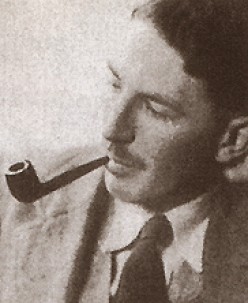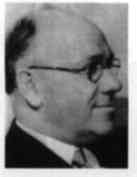<Back to Index>
- Mathematician William Gordon Welchman, 1906
- Cryptographer Edward Wilfred Harry Travis, 1888
PAGE SPONSOR

(William) Gordon Welchman (15 June 1906, Bristol, England – 8 October 1985, Newburyport, Massachusetts) was a British - American mathematician, university professor, World War II code breaker at Bletchley Park, and author.
Gordon Welchman studied Mathematics as a scholar at Trinity College, Cambridge from 1925 to 1928. In 1929 he became a Research Fellow in mathematics at Sidney Sussex College, Cambridge, a Fellow in 1932, and later Dean of the College.
Just before World War II, Welchman was invited by Commander Alastair Denniston to join the Government Code & Cypher School at Bletchley Park, in case war broke out. He was one of four early recruits to Bletchley (the others being Alan Turing, Hugh Alexander and Stuart Milner - Barry), who all made significant contributions at Bletchley, and who became known as 'The Wicked Uncles'. They were also the four signatories to an influential letter, delivered personally to Winston Churchill in October 1941, asking for more resources for the code breaking work at Bletchley Park. Churchill responded with one of his 'Action This Day' stickers.
Welchman envisaged an enhancement to Alan Turing's improved design of the Polish electro - mechanical Enigma cipher breaking machine, the bombe. Welchman's enhancement, the 'diagonal board', rendered the device substantially more efficient in the attack on ciphers generated by the German Enigma machine. Bombes became the primary mechanical aid in breaking Enigma ciphers during the war, by speeding up the search for current settings being used with the Enigma machines; these were changed often, initially at least once per day.
Welchman was head of Hut Six, the section at Bletchley Park responsible for breaking German Army and Air Force Enigma ciphers. In 1943 he became Assistant Director in charge of mechanization, and also had responsibility for cryptographic liaison with the U.S.A..
Welchman moved to the United States in 1948, and taught the first computer course at MIT. He followed this by employment with Remington Rand and Ferranti. He became a naturalized American citizen in 1962. In that year, he joined the MITRE Corporation, working on secure communications systems for the U.S. military. He retired in 1971, but was still retained as a consultant. In 1982, McGraw - Hill published his book The Hut Six Story in the U.S.A., the British version being published by Allen Lane. The book was frowned on by the National Security Agency, and its author lost his security clearance (and therefore his consultancy with MITRE), and was forbidden to discuss his book or his wartime work with the media. The offending book was, however, not banned. His final conclusions and corrections to the story of wartime code breaking were contained in a paper published posthumously in 1986 (Welchman having died in 1985) 'From Polish Bomba to British Bombe: the birth of Ultra' in Intelligence & National Security, Vol 1, No l. The entire paper was included in the revised edition of The Hut Six Story published in 1997 by M & M Baldwin.
He was survived by three children, two stepchildren and eight grandchildren.

Sir Edward Wilfred Harry Travis KCMG CBE (24 September 1888 – 23 April 1956) was a British cryptographer and intelligence officer, becoming the operational head of Bletchley Park during World War II, and later the head of GCHQ.
Educated locally in Blackheath, Travis joined the Royal Navy in 1906 as a Paymaster officer, and served on HMS Iron Duke. From 1916 to 1918, he worked on Navy ciphers. He retired in the 1920s, having reached the rank of Paymaster Commander.
By 1925, he was in charge of security at the Government Code and Cypher School (GC&CS) and deputy to Alastair Denniston. Travis replaced Denniston as the operational head of Bletchley Park in February 1942, although both took the title of Deputy Director. This may have happened because in October 1941, Alan Turing had written directly to Churchill on behalf of the cryptanalysts, over the head of Denniston, to alert Churchill to the fact that a shortage of staff at Bletchley Park was preventing them from deciphering many messages, to the detriment of the war effort. Turing had also praised the "energy and foresight" of Commander Travis. Turing's biographer says that after the change, Travis "presided over an administrative revolution" reconciling the management structure to the production process.
Travis was involved with William Friedman in working on the 1943 BRUSA Agreement and the subsequent 1946 UKUSA Agreement. Travis remained head of the post - war successor to GCCS, GCHQ, and served as its director until 15 April 1952, when he was replaced by Eric Jones.
Travis was appointed CBE in 1936, and KCMG in June 1944.